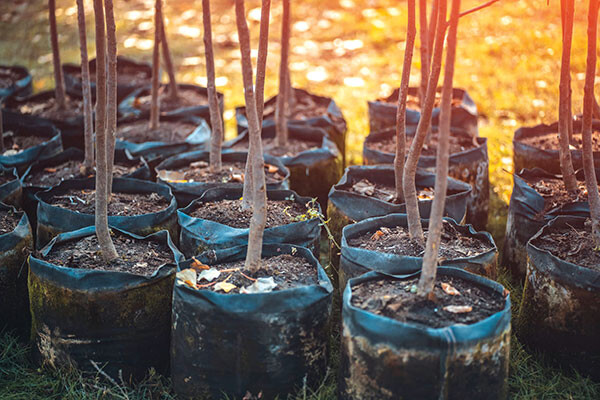 Written by Adam Russell
Written by Adam Russell
In Texas, late-fall and early winter is the perfect time to plant shade trees.
Texas A&M Forest Service and Texas A&M AgriLife Extension Service offer some expert advice to help you get your sapling out of the container, into the ground and off to a good start.
Transplanting and establishing container trees is a relatively easy process if you follow Texas A&M AgriLife Extension Service recommendations. Now is a good time to apply these tips and get shade trees in the ground.
Eric Taylor, Ph.D., a Texas A&M Forest Service silviculturist and AgriLife Extension forestry specialist, Overton, said these recommendations will go a long way to improve transplant survivability and performance.
“Planting shade trees is pretty simple,” Taylor said. “But there are certainly science-based tips that can get them off to a good start and improve the overall development of your transplanted tree.”
When to plant shade trees
Taylor said trees in containers or burlap bags can be planted at any time throughout the year if they are properly cared for. But the best time to plant deciduous trees is when they are dormant – late-fall to early spring.
He prefers planting in the fall as soon as there is sufficient soil moisture.
“I say early fall because roots are often actively growing during the winter months and that will help the tree get acclimated to the location,” he said. “That potential for a few more months of root growth can help. The larger the root system, the better off that tree will be in the summer.”
Shade trees planted in spring or summer can survive and do well, but they will need more attention, such as more frequent watering, he said.
Right shade tree, right site
Taylor said choosing the right tree to plant and planting location are important decisions. Texas A&M Forest Service has a tree selector website that can help landowners decide.
“We have loads of tools to help in the selection process, but once you decide, it’s important to get a good, quality tree. Make sure you scrutinize it before purchasing or planting. If you hire a professional planter, still look over the tree for potential problems.”
Some potential problems to look for include wounds, breaks, multiple stems and unhealthy, rootbound or girdling roots, Taylor said.
Make sure the tree has a strong, single stem. Co-dominant stems create weak points for the tree. The junction point makes them more susceptible to failure or damage from gravity or wind events and allows moisture to gather, which can promote insects and diseases.
Look for trees wounded from lines tied to prevent them from blowing over, which can cause damage to the cambium, the growth layer of the tree just under the protective bark. Damage to the cambium layer can prevent formation of new wood and bark, and transportation of sugars to growth centers of the tree. This may eventually kill large portions of the tree or the entire tree, he said.
“Once the cambium is choked, it’s hard to recover above that point,” he said. “So, look for any wounds, and avoid using tie lines that won’t distribute the tension enough to avoid injuring the cambium.”
Roots should be inspected too, Taylor said. Carefully examine the root system to make sure they are healthy. Look for numerous small, whitish roots. Roots that are brown throughout are exhibiting signs of inadequate water and other potential problems.
Make sure the roots are not girdling, or wrapping, around the base of the tree, he said.
“Some root girdling is OK because you can carefully move or adjust the roots to where they point straight away from the base of the tree when you plant the tree,” he said. “Significant girdling is a sign that the tree has been root bound for too long and will likely have problems post-planting. It may live several years, but eventually it will decline and die or be easily uprooted by high-winds because it’s roots weren’t able to grow outward to support upward growth.”
How to plant your shade trees
Taylor suggests digging a planting hole at least twice the width of a shade tree’s pot. The hole should be deep enough for the root collar – a distinct line where the tree’s roots and stem meet – to be level with the ground.
“You don’t want too deep or too shallow,” he said. “The tree’s root collar should be no more than an inch below the soil when planted, but you also don’t want roots to be exposed to the open air.”
Do not pull the tree by the stem when removing it from a container because of potential damage to the cambium layer, Taylor said. Lay the container on its side, the push on its sides as you rotate to loosen the soil before carefully removing the pot from the tree.
Make sure the roots are ready to explore new soil and not wrapped around each other or pointing upward, he said.
“It’s OK to take a sharp knife and gently cut from top of root ball to bottom in several locations so that they are able to grow directly outward,” he said. “You can gently finagle the roots and move them around where they are facing outward, away from the trunk. Having them pointing straight out is the key.”
However, you must limit root exposure to open air, he said. Prolonged exposure to air can kill the tender young roots.
Root direction is crucial, Taylor said. Trees planted with bounded roots are likely to decline rapidly around 10-15 years because as the bounded roots and trunk grow in girth, they girdle and strangle the cambium layer if it survives the planting.
Taylor said you can test for root binding and girdling in young trees already planted by rocking the tree back and forth. If the base of the tree moves, the roots have not explored the soil and could be replanted in some cases.
Once the tree is in place, backfill the hole carefully with good quality soil, he said. Mix in some sand if the soil removed is heavy with clay. This will help the roots explore. Do not use mulch in the soil mix because it contains elements limiting root growth.
Mulch can be used on the surface, but only a thin layer to minimize weeds and the need to use string trimmers near it.
“I don’t use mulch, but a little on top doesn’t hurt,” Taylor said. “It can help cut down on grass and weeds growing around the tree, which can prevent it from being killed by string trimmers. I always caution people about using a string trimmer around young trees with very thin bark because irreparable damage can happen quickly.”
Watering newly transplanted shade trees
Taylor said watering correctly is the next critical aspect of helping the transplanted tree establish. The key to remember is water to promote root expansion.
“There’s a lot of advice to use a watering can or water hose at the base of the tree or to create a mulch or soil berm around the perimeter of the tree to hold moisture,” he said. “But constant watering at the base of the tree prevents roots from seeking moisture in new soil, and the berm filled with water could drown the roots or cause fungal diseases and root rot.”
Taylor suggests watering with a soaker hose just beyond the root ball to begin. At each watering, run the soaker hose until moisture reaches 10-15 inches into the soil. No water should run off the soil. If it does then your soaker hose is on too high.
“Sprinklers do very little for trees,” he said. “Trees need the water to reach deeper, so a separate watering regimen is needed. Block the sprinkler water from reaching the tree because there can be fungal problems from sprinkler water getting on the leaves. Keep supplemental water off of the tree.”
Watering frequency will depend on rainfall and temperatures, Taylor said. Newly planted trees, with their small root system, will need watering every three to four days for the first summer. Sandy soils may need more frequent watering than loamy or clay soils.
It’s best to water in the early evening to help trees recover from the heavy transpiration demands during the day, he said.
Fertilizer is a ‘no-no’
Taylor said newly planted trees should not be fertilized. Fertilizer will artificially force the tree to elongate and grow its tips beyond its grow potential form.
Fertilizing can help fortify healthy trees to resist decline from a tough spring or early summer, he said, but fertilizers are not necessary for newly planted trees.
“Fertilizing newly planted trees, or any tree that is under stress, whether it’s disease or pests or the stress of transplanting, is not good,” he said. “You don’t want the tree to use carbohydrate reserves to grow. Instead, the tree needs those reserves to produce defensive compounds and respond to stress.”
Staking a tree for support
Most smaller transplants won’t need supports to keep them stable, but larger trees or a tall tree replanted to fix root-binding may need stakes, Taylor said.
Taylor said to be careful when staking trees for support. Use straps designed for the task or anything that creates a large surface area to distribute the pressure along the stem to protect the cambium. Also, make sure the support points are not wrapped too tightly around the tree.
“You can find tie points for sale, but I’ve seen people use items around the house like old rubber hoses, which are good,” he said. “You want something that won’t cut into the cambium and that can be adjusted.”
An eyebolt can also be screwed into the stem of the tree at the proper height to provide support in multiple directions, he said.
“An eyebolt creates one little wound rather than the risks associated with wrapping something around the tree,” he said. “Once the tree stabilizes, you can remove it and the tree will respond quickly and fill the hole.”
Taylor does not recommend using the eye-bolt method in areas with known cases of oak wilt because the disease enters through open wounds.
Go native
Taylor said tree choice is a matter of preference, but he recommends planting species native to the region.
“Native species perform better than out-of-place, non-native trees,” he said. “Native species like black gum and swamp chestnut oak have the same, desired properties people want like fall color and shade but are often much hardier and resistant to environmental stressors than their non-native options.”
Taylor said Texas A&M Forest Service has several web applications that provide good tree species options and recommendations for specific Texas regions and how to care for trees, including managing pests and diseases.














